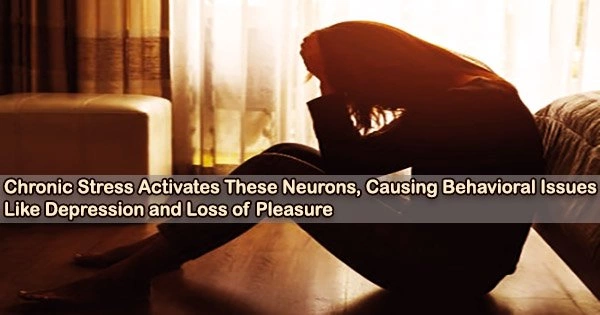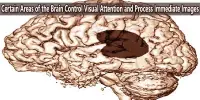It is obvious that persistent stress can affect our behavior, resulting in issues like sadness, a loss of interest in activities that used to make us happy, and even PTSD.
Researchers now have proof that persistent stress causes a subpopulation of neurons in the bow-shaped region of the brain to become hyperactive. These kinds of behavioral issues arise when these POMC neurons are overly active, and when researchers lower their activity, it lowers the behaviors, they report in the journal Molecular Psychiatry.
Scientists at the Medical College of Georgia at Augusta University looked in the hypothalamus, key to functions like releasing hormones and regulating hunger, thirst, mood, sex drive and sleep, at a population of neurons called the proopiomelanocortin, or POMC, neurons, in response to 10 days of chronic, unpredictable stress.
The effects of chronic unpredictable stress, which in this case comprised social isolation, extended wet bedding in a tilted cage, and constraint, are frequently studied in animal models.
They found the stressors increased spontaneous firing of these POMC neurons in male and female mice, says corresponding author Xin-Yun Lu, MD, PhD, chair of the MCG Department of Neuroscience and Regenerative Medicine and Georgia Research Alliance Eminent Scholar in Translational Neuroscience.
Anhedonia, or the seeming inability to experience pleasure, and behavioral despair, which is essentially depression, also appeared when scientists immediately triggered the neurons as opposed to allowing stress boost their firing.
In humans, signs of anhedonia may include a lack of libido and a cessation of interaction with close friends. Mice lose some of their usual enthusiasm for sugar water, and male mice who often enjoy sniffing females’ urine while they are in heat do the same.
Conversely when the MCG scientists inhibited the neurons’ firing, it reduced these types of stress-induced behavioral changes in both sexes.
“The results indicate POMC neurons are ‘both necessary and sufficient’ to increase susceptibility to stress, and their increased firing is a driver of resulting behavioral changes like depression. In fact, stress overtly decreased inhibitory inputs onto POMC neurons,” Lu says.
The POMC neurons are in the arcuate nucleus, or ARC, of the hypothalamus, a bow-shaped brain region already thought to be important to how chronic stress affects behavior.
Another population of neurons known as AgRP neurons, which are crucial for resilience to chronic stress and depression, also reside in this area, according to research published by Lu and her team in Molecular Psychiatry in early 2021.
Lu’s lab found that when under constant stress, AgRP activation decreases along with behavioral modifications like anhedonia, and that the behaviors improved when the neurons were activated. Her team also wanted to know what chronic stress does to the POMC neurons.
AgRP neurons, better known for their role in us seeking food when we are hungry, are known to have a yin-yang relationship with POMC neurons: When AgRP activation goes up, for example, POMC activation goes down.
“If you stimulate AgRP neurons it can trigger immediate, robust feeding,” Lu says. Food deprivation also increases the firing of these neurons. It’s also known that when excited by hunger signals, AgRP neurons send direct messages to the POMC neurons to release the brake on feeding.
They discovered via their research that persistent stress upsets the yin-yang equilibrium between these two neuronal populations. Although AgRP’s projection to POMC neurons is clearly important for their firing activity, the intrinsic mechanism is probably the major mechanism underlying hyperactivity of POMC neurons by chronic stress, Lu says.
The potassium channels in POMC neurons, which are known to respond to a variety of different inputs and, when open, cause potassium to flow out of the cell and reduce neuronal excitation, may be part of the intrinsic mechanism.
The authors hypothesize that stress also affects the potassium channels and that opening those channels would be a feasible targeted therapy to calm the erratically firing POMC neurons. However, the potential significance of these potassium channels in POMC neurons in response to stress needs further study.
Seizures are also known to result from excessive neuronal activity, and anticonvulsants are administered to open potassium channels and reduce that excessive firing. The research from the Lu lab may assist to clarify why these medications may also be effective in treating depression and anhedonia, as there is some preliminary clinical evidence to support this.
Lu hasn’t looked yet, but she wants to learn more about the function of these channels in POMC neurons in order to better understand how stress affects them and how to best target the channels if their findings continue to show they are essential for stimulating POMC neurons.
According to the American Psychological Association, chronic stress has an impact on every physiological system. Even muscles tense as a precaution against pain and harm. Shortness of breath can be brought on by stress, especially in people who already have respiratory conditions like asthma. Long-term effects include an increase in the risk of hypertension, heart attacks, and strokes, as well as changes to the beneficial bacteria in our guts that aid in digestion.
The research was funded by the National Institutes of Health.
















